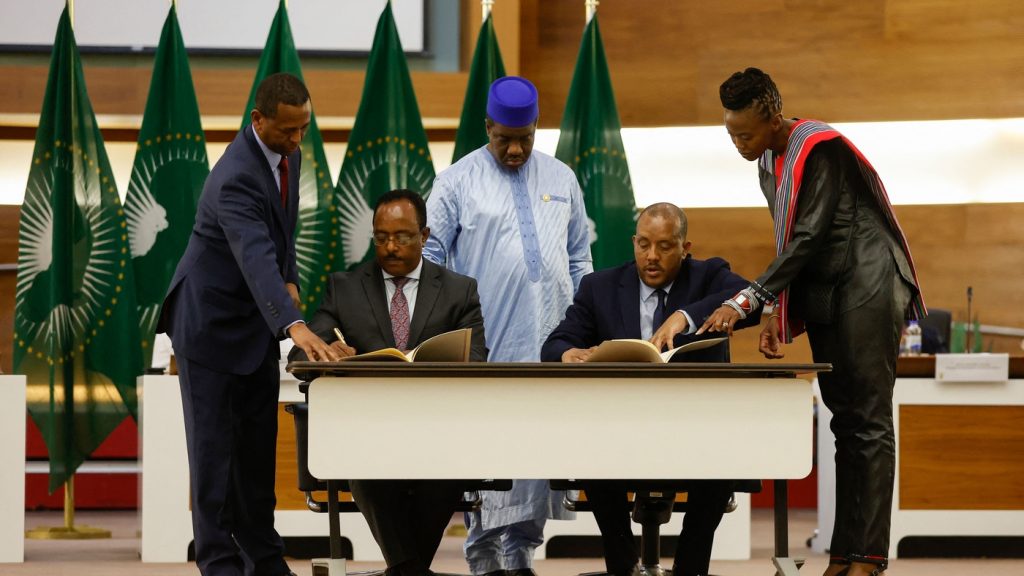The First Day of the Ethiopian–Eritre Peace Process: Violations of a “Tigray” Agreement
The world is watching to see if the end of one of the world’s most brutal conflicts can be reached following the signing of a landmark peace deal in Ethiopia.
The negotiators and foreign officials praised the deal as a first step but warned that more needs to be done to reach a lasting political settlement. “This moment is not the end of the process, but the beginning of it,” said Olusegun Obasanjo, the African Union special envoy and former Nigerian President.
“It is now for all of us to honor this agreement,” said the lead negotiator for Ethiopia’s government, Redwan Hussein. Lead Tigray negotiator Getachew Reda expressed similar sentiment, and noted that “painful concessions” have been made.
Forces from Ethiopia’s neighboring Amhara region also have been fighting Tigray ones, but Amhara representatives are not part of the peace talks. “Amharas cannot be expected to abide by any outcome of a negotiations process from which they think they are excluded,” said Tewodrose Tirfe, chairman of the Amhara Association of America.
Eritrean forces have been blamed for some of the conflict’s worst abuses, including gang-rapes, and witnesses have described killings and lootings by Eritrean forces even during the peace talks. On Wednesday, a humanitarian source said several women in the town of Adwa reported being raped by Eritrean soldiers, and some were badly wounded. The source, like many on the situation inside Tigray, spoke on condition of anonymity for fear of retaliation.
A critical question is how soon aid can return to Tigray, whose communications and transport links have been largely severed since the conflict began. Doctors have described running out of basic medicines like vaccines, insulin and therapeutic food while people die of easily preventable diseases and starvation. United Nations human rights investigators have said the Ethiopian government was using “starvation of civilians” as a weapon of war.
The War in Tigray: Bringing Peace and Development to the First Seven Years of the War, as Revisited by the Emergency Coordination Center
“We are back to 18th century surgery,” a surgeon at the region’s flagship hospital said at an online event. It’s like an open-air prison.
The humanitarian source said they can resume operations almost immediately if unrestricted aid is granted to Tigray. “It entirely depends on what the government agrees to … If they genuinely give us access, we can start moving very quickly, in hours, not weeks,” said the source, who spoke on condition of anonymity because they were not authorized to speak publicly.
The brutal fighting, which also spilled into the neighboring Amhara and Afar regions as Tigray forces tried to press toward the capital, was renewed in August in Tigray after months of lull that allowed thousands of trucks of aid into the region. According to minutes of a Tigray Emergency Coordination Center meeting on Oct. 21, seen by the AP, health workers reported 101 civilians killed by drone strikes and airstrikes, and 265 injured, between Sept. 27 and Oct. 10 alone.
Ethiopia’s prime minister said in a speech before the peace talks’ announcement that “we need to repeat the success we had on the battlefield” in peace efforts. The war is ending in northern Ethiopia. we will now bring peace and development.”
The warring sides agreed to a deal Wednesday as the war was approaching the two-year mark. The fighting has killed hundreds of thousands of people, uprooted millions from their homes and devastated one of Africa’s biggest economies.
Some people disagree about who fired the first shots. Abiy’s government blames the TPLF for attacking a federal army base in Tigray, while TPLF officials say they were preempting an invasion of their region by federal troops and allied ones from neighboring Eritrea.
The TPLF once dominated Ethiopia’s politics, at the helm of a coalition that ruled with an iron first for 27 years, but was ousted by protests in 2018.
The tension came to a head when the August 2020 elections were delayed. Tigray’s federal funding was suspended when TPLF went ahead with its own vote.
Ethiopian federal troops and their Eritrean allies captured Tigray’s major towns and roads in the early days of the war, but they were pushed out of the region in June 2021 in the face of a guerrilla campaign from the TPLF.
After a lull in the fighting in March, hostilities erupted again late in August, but federal forces made significant gains last month, taking control of several towns in Tigray.
The war was fought under a lot of communications and internet power cuts. There is a lack of news leaks from the war zone due to the fact that the internet and phone lines are down.
The conflict has caused a large number of troops to mobilize, and it is estimated that 500,000 and 1 million people are involved in the fighting. “In terms of international comparison, this is currently the largest conflict in the world right now,” says a Western diplomat, talking on background.
The Status of the Northern TPLF, its Armed Forces, and the Fate of Tigray (Angola)
The TPLF has also agreed to disarm and demobilize its large armed force, while the federal government will restore its authority in the region by assuming control of its roads and airports. The implementation of the deal will be monitored by a team of experts overseen by the African Union (AU), a group of 55 member states, which brokered the deal.
Another issue is the fate of western Tigray. The Amhara forces occupied the area in the beginning of the conflict. Amhara politicians insist the land is rightfully theirs, but Tigray’s leadership has previously demanded its return.
